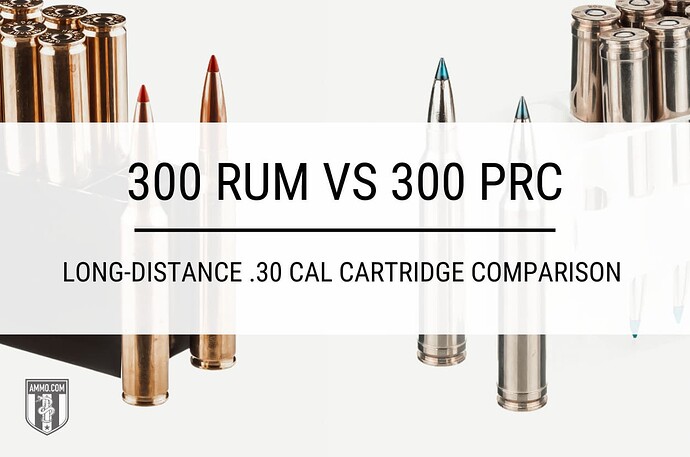.30 caliber cartridges have dominated the minds and ranges of American shooters for over a century.
In recent decades, the 300 Remington Ultra Magnum (RUM) and 300 Precision Rifle Cartridge (PRC) have each been proposed as the ultimate solution for long-range shooting.
Each has some downfalls that make the other better in specific instances, however, which you’ll discover as you continue reading this 300 RUM vs. 300 PRC comparison article.
What Is the Difference Between 300 RUM and 300 PRC?
There’s no doubt that Jack Sparrow’s favorite cartridge would be the 300 RUM, simply for the name. But you’re reading the wrong article if you’re basing which cartridge is better on a fictional character and circumstances.
To discover the difference between these two .30 caliber cartridges, we’ll compare and contrast them in real-world situations, evaluating recoil, trajectory, accuracy, stopping power, and overall cost.
But first, let’s see their similarities and differences in cartridge specifications.
Cartridge Specs
Let’s get into the nitty-gritty details of technical specifications for each cartridge.
The .300 RUM and .300 PRC were based on different parent cases, which explains why they use varying approaches to accomplish the same goal (launching a bullet WAY downrange). The 300 RUM is based on the .404 Jeffery, whereas the 300 PRC is based on the .375 Ruger.
They have the same bullet diameter (.308 in) and similar neck diameters (.344 in for the 300 RUM and .341 in for the 300 PRC), but the base diameter of the 300 RUM is expanded to .55 in contrast with .532 in of the 300 PRC.
The 300 Ultra Mag also has a longer case of 2.85 in compared to 2.58 in for the 300 PRC. The 300 PRC has a longer overall length of 3.7 in; 300 RUM overall length is 3.6 in.
The 300 RUM’s larger base diameter and longer case mean its case capacity is 110.2 grains H2O, compared to the 300 PRC’s case capacity of 77 grains H2O. However, the cartridges have the same maximum pressure of 65,000 psi.
Now, let’s see how these similarities and differences translate into real-world performance, starting with recoil.
Recoil: 300 PRC vs. 300 RUM
Recoil is a crucial aspect to consider before choosing a new cartridge for target shooting or hunting. A rifle with lots of recoil is unpleasant to fire and indirectly affects a shooter’s accuracy and efficiency (flinching as you fire, quickly realigning your sights with the target, etc.).
The recoil of a round is determined by the muzzle velocity (fps), propellant weight, rifle weight, and bullet weight. Felt recoil varies from shooter to shooter, making it unquantifiable. But recoil energy is measurable.
When fired from a 14.5 lb rifle, like the Barrett MRAD bolt-action rifle, a 300 PRC 225 grain Hornady ELD Match (ELD-M) bullet launched at 2,810 fps will have a free recoil energy of around 22 ft-lbs.
When fired from a 9 lb rifle, like the Remington 700 bolt-action rifle, a 300 RUM 230 grain Berger Hybrid bullet launched at 2,975 fps has a recoil energy of around 41 ft-lbs. This recoil is from a lighter rifle and heavier bullet, but the 300 RUM will generally have a heavier recoil than the 300 PRC (34.97 ft-lbs for the 300 RUM versus 32.42 ft-lbs for the 300 PRC).
While neither cartridge is easy on the shoulder, the 300 PRC wins this section and takes the early lead because it has less recoil.
Trajectory
Trajectory quantifies the bullet’s flight path to its target. It is an arch, often measured in inches of bullet drop. A flatter trajectory is preferred for long-distance shooting because the shooter makes fewer adjustments to remain accurate at varying distances.
When firing a Remington Premier Long-Range 215 grain bullet with a muzzle velocity of 2,180 fps, the 300 PRC projectile will drop -39 in at five hundred yards when zeroed in at 200 yards.
However, for the Remington Premier A-Frame 200 grain bullet with a muzzle velocity of 3,032 fps, the 300 RUM projectile will only drop -29.2 in at five hundred yards when sighted in at 200 yards. The 300 RUM will have a flatter trajectory than the 300 PRC due to the higher muzzle velocities with similar bullet weights.
The .300 Ultra Mag wins this section and ties up the comparison.
Continue reading 300 RUM vs. 300 PRC: Long-Distance .30 Cal Cartridge Comparison on Ammo.com

